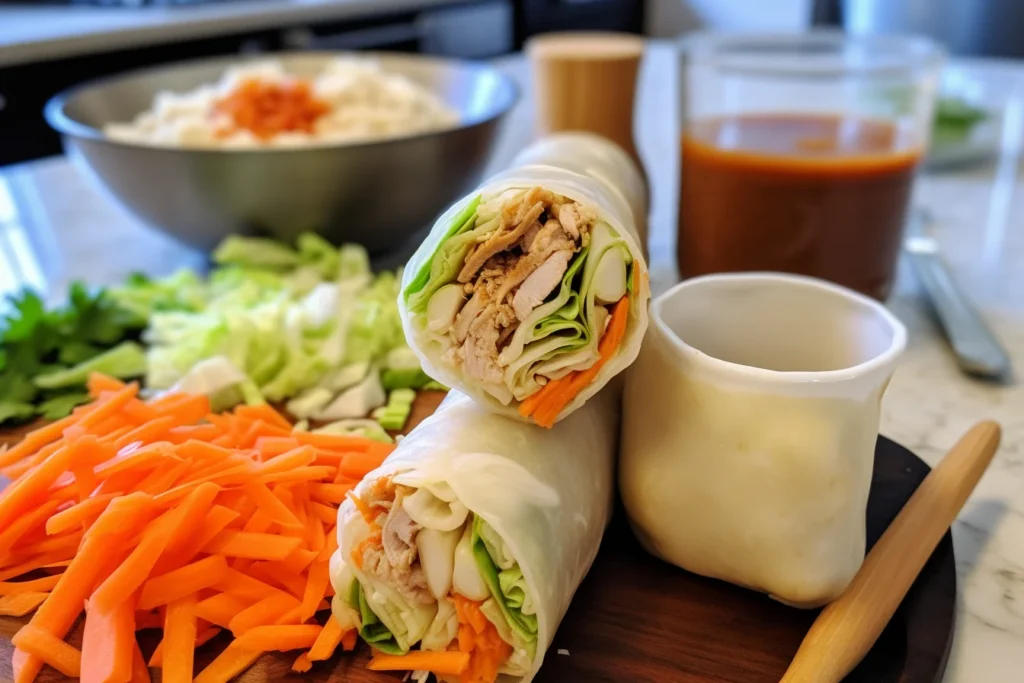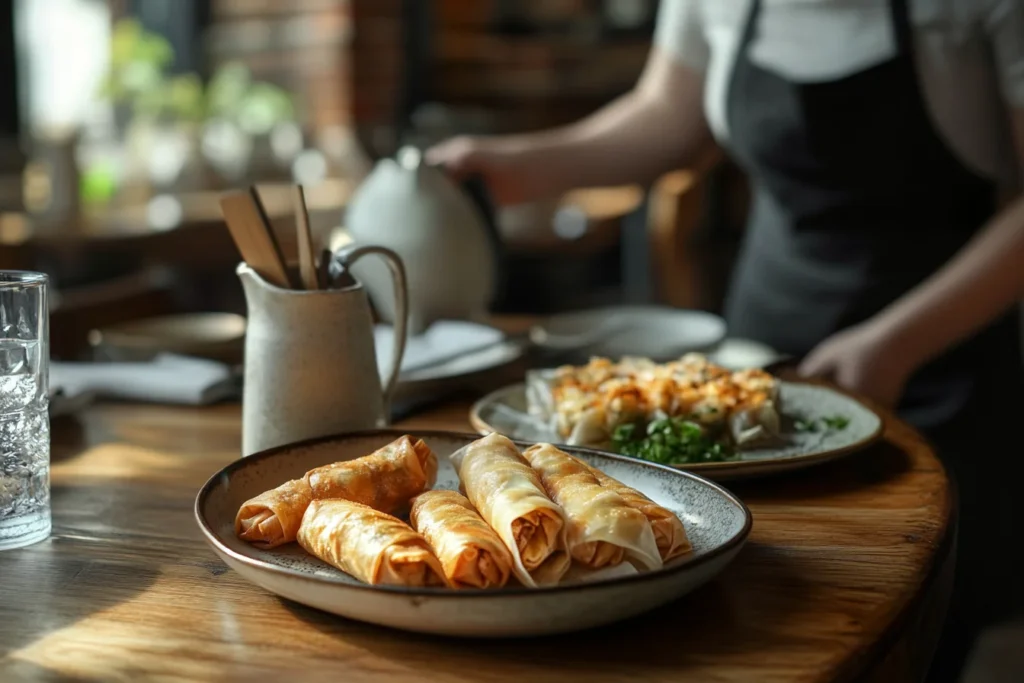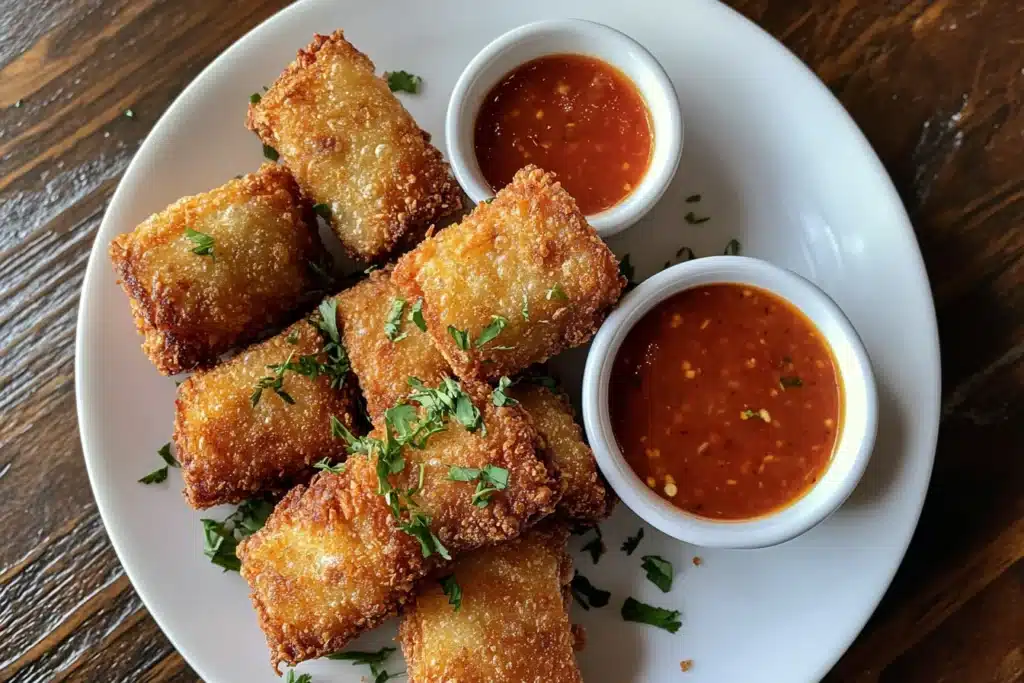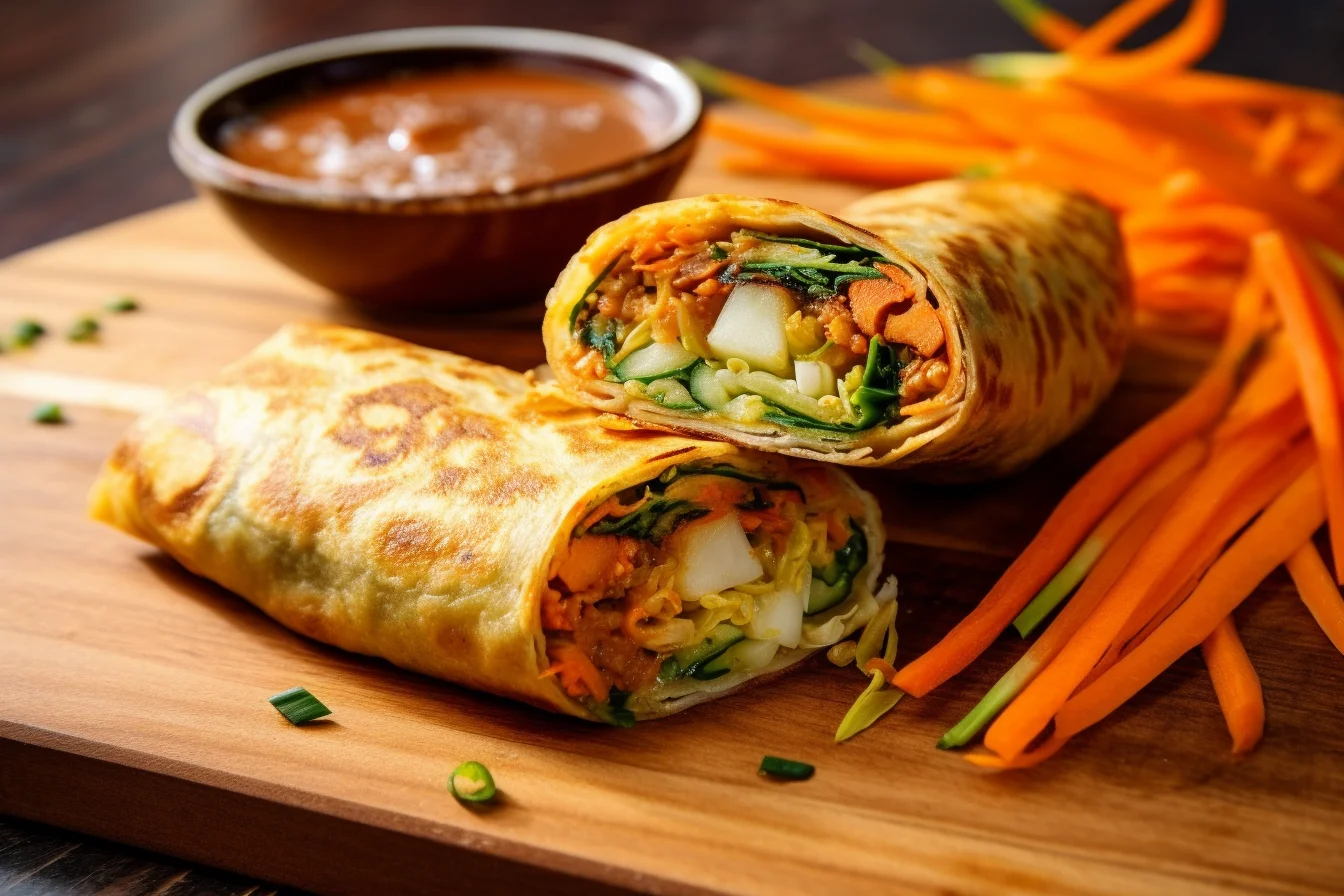Table of contents
Introduction: The Great Egg Roll Gluten Mystery
Alright, let’s talk egg rolls. Those crispy, savory bundles of deliciousness are a staple at many restaurants and family gatherings. But if you’re navigating a gluten free lifestyle, you’ve probably asked yourself, “Are egg rolls gluten free?” It’s a totally valid question! The answer, unfortunately, isn’t a straightforward yes or no. It’s more of a “it depends,” which, let’s be honest, is rarely the answer we want to hear. Therefore, we’re going to crack this egg roll conundrum wide open, exploring the ingredients, potential pitfalls, and how to enjoy these treats safely if you are avoiding gluten. Let’s get to it, shall we?
What Exactly Is an Egg Roll?

The Anatomy of an Egg Roll
First things first, let’s break down what actually makes an egg roll. Traditionally, it consists of two main components: the wrapper and the filling. The wrapper is typically a thin sheet made from wheat flour, water, and sometimes egg. Think of it like a super thin pancake. The filling, on the other hand, is a glorious mix of shredded cabbage, carrots, other vegetables, and usually some kind of meat (like pork or chicken). Soy sauce is also usually in the mix, providing that savory umami flavor we all know and love. In addition to these core components, there can be regional variations that include different spices and vegetables, further complicating the issue of gluten.
The Gluten Culprit: The Wrapper
Okay, here’s where we hit the gluten snag. That oh-so-crispy wrapper? Yeah, it’s most often made with wheat flour. And wheat flour, as you probably know, is a major source of gluten. Gluten is a protein found in wheat, barley, and rye, which gives dough its elasticity. That elasticity helps make those wrappers perfectly foldable and crispy when fried. Consequently, the very thing that gives egg rolls their iconic texture is also the primary source of gluten.
Common Ingredients and Their Gluten Status
Beyond the Wrapper: Hidden Gluten Sources
Now, while the wrapper is the prime suspect, we can’t just assume that’s the only gluten hanging around. There are other culprits to be aware of. Soy sauce, for instance, is often a biggie. Many commercially available soy sauces contain wheat, which is used in the fermentation process. Also, some cheaper versions of soy sauce are filled with wheat to increase the volume. Then, we’ve got the fillings. Sometimes, these may contain small amounts of flour or ingredients that have been processed in facilities where cross-contamination is a risk.
Cross-Contamination: A Silent Saboteur
Oh boy, cross-contamination! This is the sneaky fellow that can get you even when the ingredients should be gluten free. For example, this can happen during the preparation process. If egg rolls are fried in the same oil as gluten-containing foods, or prepared on the same surfaces, cross-contamination can occur. This is a real concern in restaurants where many different types of food are prepared in the same kitchen. Because of this, you can’t always be sure that what should be gluten free, really is. This is why it’s always best to ask the kitchen how their egg rolls are prepared, especially if you have a sensitivity or allergy.
Navigating the Gluten Free World of Egg Rolls
Are Store-Bought Egg Rolls Gluten Free?
Okay, so you’re standing in the frozen aisle, eyeing that box of egg rolls. Are they safe? Most of the time, the answer is going to be no. Frozen or pre-made egg rolls from the grocery store are rarely gluten free. However, there are always exceptions! There are brands out there that make gluten free versions, so always read those labels carefully. Look for “gluten free” certification and pay close attention to the ingredient list. Some brands might use rice flour or other gluten free alternatives for the wrapper. Above all, double-check the label for possible allergens.
Restaurant Egg Rolls: A Minefield?

Eating out? This is where it gets a little trickier. Restaurants, especially those that are not specifically gluten-free, often use traditional wheat-based wrappers. They might not be aware of all the sneaky ways gluten can hide in their ingredients. It’s always a smart move to ask about ingredients and preparation methods. Don’t be shy about asking your server detailed questions about how the egg rolls are made, and whether they can accommodate gluten-free dietary needs. A little communication can go a long way! Not only that, but different cooks in the same restaurant can have different habits, further complicating the issue. Therefore, it’s always best to be cautious.
Homemade Gluten-Free Egg Rolls: The Path to Control
Making Your Own: A Safer Route
The most reliable way to ensure your egg rolls are gluten-free is to make them yourself. It gives you complete control over the ingredients. You get to choose the specific wrapper, and you know exactly what’s going into your filling. If you’re keen on avoiding that gluten, making them from scratch is your best bet! It might sound like a lot of work, but it’s actually quite fun and rewarding. Plus, you can customize the flavors to your liking. Furthermore, making egg rolls at home can be a fun activity to do with your family and friends.
Gluten-Free Wrapper Alternatives
The secret to a great gluten-free egg roll lies in the wrapper. There are some excellent options available nowadays! Rice paper wrappers are a popular choice. They’re naturally gluten-free and create a lighter, slightly chewy texture. You can, of course, find gluten-free wrappers specifically designed for egg rolls made with tapioca flour or rice flour blends. Experiment with different options to see which you prefer! Because every brand is different, you can really customize the texture of your egg rolls by trying new brands. Additionally, some people prefer the texture of spring roll wrappers compared to traditional rice paper.
Filling Options: Getting Creative
The filling is where you can really let your creativity shine. You can stick to the classics like cabbage, carrots, and meat, or branch out with different vegetables, mushrooms, or seafood. Make sure to use a gluten-free soy sauce (or tamari) and avoid using any pre-packaged sauces with hidden gluten. Go crazy with your flavors and create egg rolls that make your taste buds dance! Similarly, you can experiment with different spices and herbs to really customize your flavor profile.
Tips for Success in the Kitchen

Alright, here’s some advice for making the best gluten-free egg rolls:
- Read Labels: Double-check everything, from the wrappers to the soy sauce, to ensure they are certified gluten-free.
- Prepare Your Space: Make sure your work surfaces, utensils, and cooking equipment are all clean to prevent cross-contamination.
- Don’t Overfill: Overstuffed egg rolls will be difficult to roll and might burst open while frying.
- Use the Right Oil: Choose a high-heat oil like vegetable or canola oil for frying to achieve that perfect crispiness.
- Fry in Batches: Don’t overcrowd the pan. Fry in batches to maintain the temperature of the oil and prevent the egg rolls from getting soggy.
- Serve Hot: Egg rolls are best enjoyed fresh out of the fryer, when they’re at their peak crispiness.
The Health Benefits of Egg Rolls
Nutritional Perspective
Let’s be real, egg rolls aren’t exactly a health food, but they can be part of a balanced diet if enjoyed in moderation. The vegetables inside offer some good fiber and vitamins, which is great. But if you’re making your own, you can really boost the nutrition by adding more veggies and lean protein. It’s all about making informed choices and enjoying these tasty treats responsibly. The problem often lies with added oils and sodium, but homemade options can be far healthier. Also, you can control how much oil and salt goes into your egg roll when you make them yourself.
Potential Issues: Allergies and Sensitivities
Beyond gluten, egg rolls can contain other common allergens like eggs, soy, and sometimes even shellfish. If you are going to a restaurant be sure to check with your server for all allergens. As always, be mindful of your own dietary needs. It is always a good practice to always double check the ingredients and be on the lookout for possible cross contamination. In addition, even trace amounts of certain allergens can cause significant reactions in sensitive individuals.
Finding Gluten-Free Egg Rolls Out in the Wild
What to Ask When Eating Out
If you’re braving the restaurant scene, here are a few key questions to ask:
- “Are your egg rolls made with wheat flour?”
- “Do you have any gluten-free egg roll options?”
- “How are they prepared, and is there a risk of cross-contamination?”
- “What oil do you use for frying?”
- “Does the soy sauce used in the filling have wheat?”
Gluten-Free Friendly Restaurant Options
Some restaurants are more accommodating than others when it comes to dietary restrictions. Look for establishments that offer gluten-free menus or that are transparent about their ingredients and preparation methods. Some Asian restaurants may have rice paper options for spring rolls that could be a safe alternative. Don’t hesitate to call ahead and inquire before you go. It can save you a lot of time and potential discomfort. Also, looking online for reviews and feedback about gluten free accommodations can be very helpful.
The Rise of Gluten-Free Options
The great news is that the demand for gluten-free food is growing. Many companies are catching on. More gluten-free products are becoming available in grocery stores and restaurants. This makes it easier to find a wider variety of gluten-free options. It’s an exciting time for people following a gluten-free diet! Things are definitely improving, and that makes life just a little bit easier. Certainly, this trend will continue to grow in the future.
Diving Deeper into Cross-Contamination
Understanding the Risks
Let’s delve deeper into the sneaky issue of cross-contamination. It’s not just about the ingredients themselves, but also about how they are handled. For example, imagine a kitchen where wheat-based flour is being used to dust surfaces or bread foods. This flour dust can easily settle on surfaces, utensils, and even in the air, contaminating anything that comes into contact with it. Also, frying oil that’s been used to cook gluten-containing items can become a source of cross-contamination. This is why it’s crucial to be extra cautious, particularly if you have a severe gluten allergy or sensitivity.
How to Minimize Cross-Contamination at Home
When you’re cooking at home, there are several things you can do to minimize the risk of cross-contamination. Firstly, designate certain cutting boards, utensils, and cookware as gluten-free only. Wash them thoroughly with soap and water before and after each use. Avoid using the same oil for both gluten-free and gluten-containing foods. Also, keep your gluten-free ingredients stored separately from any foods containing gluten. Lastly, make sure that your kitchen surfaces are thoroughly cleaned before beginning to prepare a gluten-free meal.
The Role of Gluten-Free Certifications
What Does it Mean to be Certified Gluten-Free?
You’ve probably seen the “certified gluten-free” label on some products. But what does that really mean? In essence, it means that a product has been tested and verified to meet specific standards for gluten content, usually below a certain threshold. This label gives consumers more confidence that the product is safe for those following a gluten-free diet. However, certification standards can vary from country to country, so it is still important to do your research. Additionally, some certifications may be more rigorous than others, so it’s crucial to understand what the specific certification standards are.
Why Certification Matters
While you can always read the ingredients list, the “certified gluten-free” label provides an extra layer of reassurance. It means that the product has not only been tested, but also produced in a facility with specific safety protocols in place to prevent cross-contamination. The company has invested time and money to ensure they have a safe product. Therefore, these certifications are very important to ensure safety for those avoiding gluten. Similarly, many people find it much easier to purchase products that have been certified compared to those that have not.
The Art of Gluten-Free Cooking
Embracing Alternative Flours
Gluten-free cooking often involves getting acquainted with alternative flours. These aren’t just direct replacements for wheat flour, they behave differently and bring their own unique properties to the table. For example, rice flour can be great for light and crispy textures, while tapioca flour brings a nice chewiness. You can also find mixtures of multiple gluten-free flours that aim to mimic the texture of traditional wheat flour. Experimenting with different flours is all part of the fun of gluten-free cooking!
Mastering the Gluten-Free Egg Roll Wrapper
Making gluten-free egg roll wrappers from scratch can be a little tricky at first, but definitely doable with practice. You’ll need to master the right techniques for creating the dough, rolling it out, and cooking it to perfection. But once you get the hang of it, you’ll be able to whip up delicious homemade gluten-free egg rolls whenever the craving strikes. Don’t be discouraged by early failures. It takes practice and some trial and error to get it right!

Conclusion: Cracking the Code on Gluten Free Egg Rolls
So, are egg rolls gluten free? The short answer is, unfortunately, usually no. The typical wrapper contains wheat, which is a major no-go for anyone avoiding gluten. However, that doesn’t mean you have to miss out! With a little knowledge and a proactive approach, you can absolutely enjoy egg rolls while staying true to your gluten free lifestyle. Whether you choose to make them at home or find a restaurant that offers safe options, it’s all about being informed and making the right choices for you. Since you are now armed with all this information, you can make the best choices for your diet!

